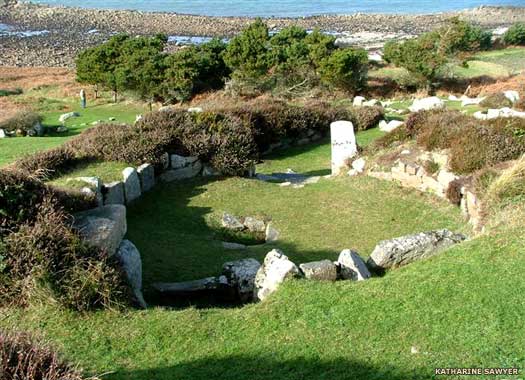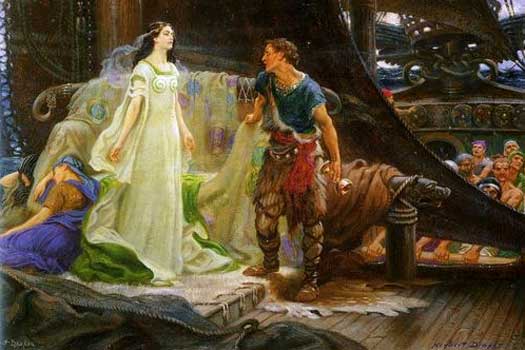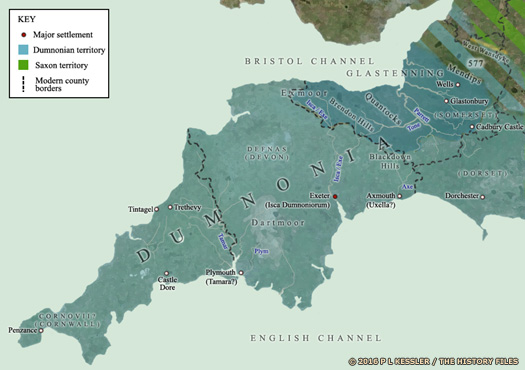 |
|
|
| (Information by Peter Kessler, with additional information by Paul Bennett, from The Landscape of King Arthur, Geoffrey Ashe, from History of the Kings of Britain, Geoffrey of Monmouth, from The Cambridge Historical Encyclopaedia of Great Britain and Ireland, Christopher Haigh (Ed), from The Oxford History of England: Roman Britain, Peter Salway, from the Historia Brittonum (The History of the Britons), Nennius, and De Excidio Brittaniae et Conquestu (On the Ruin of Britain), Gildas (both J A Giles, Ed & Trans, 1841, published as part of Six Old English Chronicles (Henry G Bohn, London, 1848)), from A History of the English Church and People, The Venerable Bede (Leo Sherley-Price translation - revised by R E Latham), from The Anglo-Saxon Chronicles, Anne Savage (translator and collator, Guild Publishing, 1983), and from External Link: Tristan & Isolde (Timeless Myths).) |
|
|
| c.500 |
According to tradition, the territory of the Isles of Scilly is granted to the son-in-law of Meirchion ab Custennyn of Cornubia, while Merchion's natural son, Cyn-March ap Meirchion, inherits Cornubia itself. Meliodas probably marries Cyn-March's sister before the death of Merchion to be in a position to receive this grant of territory. However, it is also claimed that Felec is the first king of Lyonesse, making the marriage between Meliodas and Isabelle a dynastic match.  These round building ruins are of a courtyard house at Halangy Down on the Isles of Scilly (history's possible Lyonesse), an Iron Age and Romano-British village on the isles These round building ruins are of a courtyard house at Halangy Down on the Isles of Scilly (history's possible Lyonesse), an Iron Age and Romano-British village on the isles |
|
| fl c.500? |
Felec / Ffelig / Felix |
Possibly the same as St Felix of 5th/6th century Cornwall. |
| fl c.525 |
Meliodas ap Ffelig |
Son. m Isabelle ferch Meirchion of Cornubia. |
| Meliodas ap Ffelig marries Isabelle, the daughter of Meirchion of Cornubia (late 400s). His second wife is a daughter or sister of King Hoel Mawr of Brittany, a step up on the social ladder of British nobility. |
|
|
| fl c.540 |
Tristan / Tristram ap Meliodas |
Son. Nephew of Mark (Cornubia). Drustanus? |
Tristan, son of Meirchion, is one of the main characters of the story of Tristan & Iseult. While bringing Iseult, daughter of the Irish king, to Cornubia where she is to marry King Mark, the two fall in love. They have a secret affair which is belatedly discovered by Mark. Tristan manages to escape, but the couple are later forgiven. Unlike some later works, Tristan & Iseult portrays Mark in a sympathetic fashion. Later works paint him in increasingly darker tones, making him more and more evil and less of a sympathetic figure.  The story of Tristan and Iseult is possibly one of the earliest of the Arthurian cycle of tales, and therefore has a much deeper rooting in possible historical fact The story of Tristan and Iseult is possibly one of the earliest of the Arthurian cycle of tales, and therefore has a much deeper rooting in possible historical fact |
|
|
| The sixth century Tristan Stone, near Fowey in Cornubia (close to Castle Dore) bears an inscription which marks the grave of Drustanus, son of Cunomorus. The monument is subsequently moved several times so the grave itself is lost, but its original site is closer to Castle Dore than today. The idea that Cunomorus is the same person as Mark is a persistent one, but it would mean that Tristan (a form of the extremely variable Drustanus) is his son, making the Tristan & Iseult story considerably less of a romance. Alternatively, this Mark is the slightly earlier Marcus Conomari of Dumnonia. |
|
|
| fl c.560 |
Tristan / Tristram 'the Younger' |
Son. Reputedly drowned when Lyonesse was inundated. |
| c.560 |
The diminutive territory is probably re-absorbed into Cornubia. Curiously, this seems to be around the same time that the first of a short list of kings appear in Leon in Brittany, which of course retains very strong links at this time with south-western Britain. Speaking very theoretically, perhaps the heir to Lyonesse is given British territory in Brittany in compensation for the loss of Lyonesse.  When the West Seaxe removed the entire area between Gloucester and Bath of British resistance in AD 577, the West Wansdyke appears to have remained in British hands (click or tap on map to view full sized) When the West Seaxe removed the entire area between Gloucester and Bath of British resistance in AD 577, the West Wansdyke appears to have remained in British hands (click or tap on map to view full sized) |
|
| After the Arthurian period the water levels rise substantially, partially inundating Scilly and turning it into a chain of small islands. Overall it remains part of Dumnonia, and is unconquered but is subjugated along with the remains of that kingdom, in the later form of Corniu. They remain linked as the duchy of Cornwall, and Scilly has its own governors between 1568-1920. |
|
|
 |
|
|
 With the expulsion of Roman officials in AD 409 (see feature link), Britain again became independent of Rome and was not re-occupied. The fragmentation which had begun to emerge towards the end of the fourth century now appears to have accelerated, with minor princes, newly declared kings, and Roman-style magistrates all vying for power and influence while also facing the threat of extinction at the hands of the various barbarian tribes which were encroaching from all sides. The land of Lyonesse was one which had been engulfed by the ocean. Although the name and familiar trappings of Lyonesse are almost entirely legendary, or indeed mythical, the kingdom is traditionally linked to the Isles of Scilly. These islands, lying to the west of the Land's End promontory in Cornubia (modern Cornwall) do exist and have been inhabited for many thousands of years. They form part of a low-lying region which encompasses the territory between the islands and Cornwall itself. There remains some doubt as to where Lyonesse was located. Early romancers who mention Tristan of the Tristan & Iseult story may be thinking of Lothian of the Gododdin in modern Scotland, which they called Loenois in Old French, or perhaps they were thinking of Leon (Leonais) in Brittany. If the Leon of Brittany is not one and the same as Lyonesse, then the two may still be connected, with the Britons of Lyonesse perhaps being responsible for creating the Armorican principality. Today Lyonesse is firmly rooted in Cornwall's traditions, so linking it to the Isles of Scilly seems the most logical step. Neolithic people of Early Britain lived on Scilly, at which time the chain of islands were still linked together above sea level. They constructed tombs, such as the one on St Mary's, and walls and huts which now lie below the present high-water mark. Even at that period the links between islands must have been increasingly prone to flooding. The Romans termed the isles Scillonia insula, suggesting a single island, or at least one main island. During the fifth and sixth centuries AD, they were becoming isolated but were still less submerged by water than today, so they would have presented enough land on which to warrant the founding of a small kingdom. The central plain was flooded around this time, and the inundation by water continues to this day, with water levels around the Isles of Scilly having risen five metres in the last two thousand years. At exceptionally low tides, it is still possible to walk between the islands. Folk memories of the islands' past habitation went into the gradual build-up of the legend of Lyonesse. Fisherman used to claim that the Seven Stones reef off Land's End marked the site of one of Lyonesse's vanished towns, the 'City of Lions' (note the similarity to 'Lyonesse', or even the Armorican 'Leon'), and the supposedly lost land between Scilly and the mainland was called Lethesow, or Lethowsow. The fisherman used to haul up fragments of masonry in their nets, and church bells are allegedly heard under water when the sea is stormy. Around the mainland, in the bay of St Michael's Mount which was part of the Scilly region, are the fossilised remains of a sunken forest, with beech trees still bearing nuts. Although at least some of the traditional kings of Lyonesse are known to have existed as historical, or at least likely historical, figures, elements of this list are slightly dubious and are unlikely ever to be confirmed fully. The kingdom seems to have been created around the time of Merchion ab Custennyn, king of Cornubia, probably as a vassal state, but it survived in this form for less than a century before it was reintegrated into Cornubia.
With the expulsion of Roman officials in AD 409 (see feature link), Britain again became independent of Rome and was not re-occupied. The fragmentation which had begun to emerge towards the end of the fourth century now appears to have accelerated, with minor princes, newly declared kings, and Roman-style magistrates all vying for power and influence while also facing the threat of extinction at the hands of the various barbarian tribes which were encroaching from all sides. The land of Lyonesse was one which had been engulfed by the ocean. Although the name and familiar trappings of Lyonesse are almost entirely legendary, or indeed mythical, the kingdom is traditionally linked to the Isles of Scilly. These islands, lying to the west of the Land's End promontory in Cornubia (modern Cornwall) do exist and have been inhabited for many thousands of years. They form part of a low-lying region which encompasses the territory between the islands and Cornwall itself. There remains some doubt as to where Lyonesse was located. Early romancers who mention Tristan of the Tristan & Iseult story may be thinking of Lothian of the Gododdin in modern Scotland, which they called Loenois in Old French, or perhaps they were thinking of Leon (Leonais) in Brittany. If the Leon of Brittany is not one and the same as Lyonesse, then the two may still be connected, with the Britons of Lyonesse perhaps being responsible for creating the Armorican principality. Today Lyonesse is firmly rooted in Cornwall's traditions, so linking it to the Isles of Scilly seems the most logical step. Neolithic people of Early Britain lived on Scilly, at which time the chain of islands were still linked together above sea level. They constructed tombs, such as the one on St Mary's, and walls and huts which now lie below the present high-water mark. Even at that period the links between islands must have been increasingly prone to flooding. The Romans termed the isles Scillonia insula, suggesting a single island, or at least one main island. During the fifth and sixth centuries AD, they were becoming isolated but were still less submerged by water than today, so they would have presented enough land on which to warrant the founding of a small kingdom. The central plain was flooded around this time, and the inundation by water continues to this day, with water levels around the Isles of Scilly having risen five metres in the last two thousand years. At exceptionally low tides, it is still possible to walk between the islands. Folk memories of the islands' past habitation went into the gradual build-up of the legend of Lyonesse. Fisherman used to claim that the Seven Stones reef off Land's End marked the site of one of Lyonesse's vanished towns, the 'City of Lions' (note the similarity to 'Lyonesse', or even the Armorican 'Leon'), and the supposedly lost land between Scilly and the mainland was called Lethesow, or Lethowsow. The fisherman used to haul up fragments of masonry in their nets, and church bells are allegedly heard under water when the sea is stormy. Around the mainland, in the bay of St Michael's Mount which was part of the Scilly region, are the fossilised remains of a sunken forest, with beech trees still bearing nuts. Although at least some of the traditional kings of Lyonesse are known to have existed as historical, or at least likely historical, figures, elements of this list are slightly dubious and are unlikely ever to be confirmed fully. The kingdom seems to have been created around the time of Merchion ab Custennyn, king of Cornubia, probably as a vassal state, but it survived in this form for less than a century before it was reintegrated into Cornubia.
 These round building ruins are of a courtyard house at Halangy Down on the Isles of Scilly (history's possible Lyonesse), an Iron Age and Romano-British village on the isles
These round building ruins are of a courtyard house at Halangy Down on the Isles of Scilly (history's possible Lyonesse), an Iron Age and Romano-British village on the isles The story of Tristan and Iseult is possibly one of the earliest of the Arthurian cycle of tales, and therefore has a much deeper rooting in possible historical fact
The story of Tristan and Iseult is possibly one of the earliest of the Arthurian cycle of tales, and therefore has a much deeper rooting in possible historical fact When the West Seaxe removed the entire area between Gloucester and Bath of British resistance in AD 577, the West Wansdyke appears to have remained in British hands (click or tap on map to view full sized)
When the West Seaxe removed the entire area between Gloucester and Bath of British resistance in AD 577, the West Wansdyke appears to have remained in British hands (click or tap on map to view full sized)